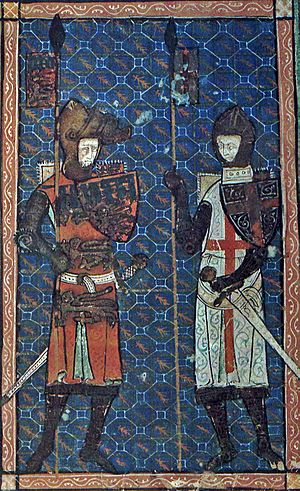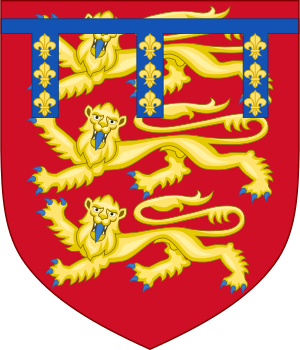Thomas, 2nd Earl of Lancaster facts for kids
Quick facts for kids
Thomas
|
|
|---|---|

Thomas (left) with St. George (right)
|
|
| Earl of Lancaster, Leicester, Derby, Lincoln and Salisbury | |
| Predecessor | Edmund Crouchback, 1st Earl of Lancaster |
| Successor | Henry, 3rd Earl of Lancaster |
| Born | c. 1278 |
| Died | 22 March 1322 (aged ~43–44) Pontefract, Yorkshire |
| Cause of death | Execution by beheading |
| Noble family | Plantagenet |
| Spouse(s) | Alice de Lacy, 4th Countess of Lincoln (m. 1294; div. c. 1318) |
| Father | Edmund Crouchback |
| Mother | Blanche of Artois |
Thomas, 2nd Earl of Lancaster (born around 1278 – died March 22, 1322) was a very important English nobleman. He was part of the royal Plantagenet Dynasty, a famous family of kings and queens. Thomas held many powerful titles, like Earl of Lancaster, Leicester, Derby, Lincoln, and Salisbury.
As one of the richest and most powerful nobles in England, Thomas became a leader of a group of barons. These barons were nobles who opposed his cousin, King Edward II.
Contents
Thomas's Early Life and Family
Thomas was the oldest son of Edmund Crouchback and Blanche of Artois. His father, Edmund, was the son of King Henry III of England. This meant Thomas was closely related to the royal family.
Thomas married a woman named Alice de Lacy. They did not have any children together. In 1317, Alice was taken from her home by a knight. This caused a big fight between Thomas and another powerful earl, John de Warenne, 7th Earl of Surrey. Thomas even took over two of Surrey's castles! King Edward II had to step in to make them stop fighting.
Even after this trouble, Thomas kept his important titles. This was because of a special agreement made when he married Alice. When her father died, Thomas got to keep the earldoms of Lincoln and Salisbury for himself.
Becoming a Powerful Earl
When Thomas became an adult, he took on many responsibilities. He spent about ten years fighting for King Edward I in Scotland. He was even at the Battle of Falkirk in 1298.
In 1308, Thomas helped at the coronation of his cousin, King Edward II of England. He carried a special sword called Curtana, which belonged to an old king, Edward the Confessor.
At first, Thomas supported King Edward II. But soon, problems grew between the king and the nobles. Thomas began to dislike the king's close friend, Piers Gaveston. Gaveston even made fun of Thomas, calling him "the Fiddler." This made Thomas very angry.
Thomas became one of the "Lords Ordainers." This was a group of powerful nobles who wanted to control the king. They demanded that Gaveston be sent away. Thomas and his own army helped separate the king from Gaveston. Thomas was also one of the nobles who decided that Gaveston should be executed in 1312.
After a big defeat for England at the Battle of Bannockburn in 1314, King Edward II had to let Thomas take charge. For the next four years, Thomas basically ruled England. However, he found it hard to keep order. He also couldn't stop the Scots from attacking and taking back land in the North. By 1318, other nobles were not as happy with Thomas, and he had to give up some of his power.
Thomas's Final Years and Death
Later, new leaders came to power, especially a father and son named Hugh le Despenser, 1st Earl of Winchester and Hugh the younger Despenser. Many nobles didn't like them either. So, in 1321, Thomas led another rebellion against the king and the Despensers.
This time, Thomas was defeated at the Battle of Boroughbridge on March 16, 1322. He was captured by the king's forces.
Thomas was put on trial by a group that included the two Despensers and King Edward II himself. Thomas was not allowed to speak to defend himself or have anyone speak for him. He was found guilty of treason, which means betraying the king. He was sentenced to death. Because he was related to the king, his sentence was changed to beheading instead of a more brutal execution. Thomas was executed on March 22, 1322, near Pontefract Castle.
After his death, Thomas's titles and lands were taken away. But in 1323, his younger brother, Henry, successfully asked to get back the earldom of Leicester. Later, in 1326 or 1327, Parliament decided that Thomas's conviction was wrong. Henry was then allowed to take control of the other earldoms: Lancaster, Derby, Salisbury, and Lincoln.
Soon after Thomas died, people reported miracles happening at his tomb. He became seen as a martyr (someone who dies for their beliefs) and a saint. In 1327, people asked King Edward III to make Thomas an official saint. Many people continued to honor him until the time of the Reformation.
In 1822, Thomas's remains were found in a stone coffin in a field. Later, in 1942, some of his bones were reportedly found in a box.
Thomas's Titles and Lands
From his father, Thomas inherited the important titles of Lancaster, Leicester, and Derby.
Through his marriage to Alice de Lacy, Countess of Lincoln, he gained even more titles. When her father died in 1311, Thomas became Earl of Lincoln, Earl of Salisbury, 11th Baron of Halton, and 7th Lord of Bowland. With five earldoms, he was one of the richest and most powerful men in England.
Thomas owned many important castles, especially in northern England, like Clitheroe Castle. He made Pontefract Castle bigger and stronger. In 1313, he also started building Dunstanburgh Castle, a huge fortress in Northumberland.
Family Tree
Thomas was closely related to both the Capetian kings of France and the Plantagenet kings of England. People at the time said that because both his parents were from royal families, he was "clearly of nobler descent than the other earls."



